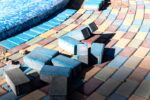 Pool resurfacing is repairing or replacing the surface of a swimming pool. This can have several different purposes, including restoring an old or worn-out pool to like-new condition, increasing its aesthetic appeal, or making it more functional for recreational use. Over time, the pool’s surface will become worn and damaged, making it necessary to replace it. There are a variety of resurfacing materials available on the market, each with its own advantages and disadvantages.
Pool resurfacing is repairing or replacing the surface of a swimming pool. This can have several different purposes, including restoring an old or worn-out pool to like-new condition, increasing its aesthetic appeal, or making it more functional for recreational use. Over time, the pool’s surface will become worn and damaged, making it necessary to replace it. There are a variety of resurfacing materials available on the market, each with its own advantages and disadvantages.
Deciding on one type of resurfacing material may prove challenging. Letting a San Diego pool resurfacing contractor advise you is the easiest and most reliable method to ensure you choose the best material. In the following article, we’ll take a closer look at the different materials and how to find the one that best suits your pool. Read on!
What are the different materials for pool resurfacing?
Depending on the surface, pool surface repairs will extend its lifespan up to ten years or more. The need to resurface your pool usually occurs every 5-15 years. Here are three optimum materials to choose from as you get ready for your pool resurfacing:
1. Concrete
Concrete is an excellent material for resurfacing a pool. It’s durable, water-resistant, and relatively easy to install. Plus, it can withstand extreme temperatures and UV rays without cracking or fading.
There are several different options when it comes to concrete pool coatings. You can choose from standard colored concrete, decorative concrete that includes hand-stained artistry or printed logos, polished concrete with a high-gloss finish, faux stone finishes in granite, and other styles.
When choosing the type of concrete coating you want for your pool surface, consider the overall aesthetic you’re trying to achieve as well as any special requirements the material may have, such as tolerance for chemicals used in swimming pools or resistance to the sun’s UV rays. It’s by far the best material for pool resurfacing.
2. Pool plaster
Plaster is a popular choice for resurfacing pool surfaces because it offers many benefits. First, it is durable and long-lasting. Unlike other materials that can crack or peel over time, plaster holds up well to weathering, changes in temperature, and exposure to chemicals.
In addition to its durability, plaster also has a smooth and even texture that makes for an attractive surface. This uniformity means that the water flows evenly across the surface without any bumps or ridges getting in the way. Because the surface remains relatively level after installation, you won’t need to worry about uneven wear over time caused by swimmers moving around on the pool deck.
3. Fiberglass
This material is becoming increasingly popular as a resurfacing material. Fiberglass is extremely durable and much more resistant to wear and tear than other materials like concrete or plaster. This means it will last longer and won’t need to be replaced as often.
Apart from its easy maintenance, fiberglass is non-porous, so it doesn’t absorb dirt and grime the way other materials do. In addition, because fiberglass is a smooth, glossy surface, it can help add an attractive and modern aesthetic to your pool.
 How do I choose a material for pool resurfacing?
How do I choose a material for pool resurfacing?
When considering pool resurfacing, there are many factors to take into account in order to choose the best possible material. The first step is to assess the condition of your current surface. If there are significant cracks or other damage, it may be necessary to replace it entirely. However, if the damage is minor, resurfacing may be a more cost-effective option.
Another important factor when choosing a pool resurfacing material is maintenance needs. For example, plaster is considered a low-maintenance material, as it typically requires minimal upkeep compared to other resurfacing options. Fiberglass, on the other hand, may require more frequent cleaning and maintenance due to its slick surface.
Ultimately, the best way to choose a pool resurfacing material is by considering all of these factors carefully in order to find the option that best suits your needs and budget. With careful consideration and attention to detail, you can ensure a beautifully finished surface for years to come.
Where can I find a reliable San Diego pool resurfacing contractor?
As a renowned pool building firm with a goal to fulfill every single of our client’s wishes, we have what it takes to take care of all your pool-related needs. We don’t create pools, we create pieces of art.
Take a field trip with your family down at the San Diego Zoo while we create your precious little paradise. Our experts at So Cal Custom Pools and Spas are standing by for your call!



 5-Star Pool Builder
5-Star Pool Builder
 5-Star Rating on Facebook
5-Star Rating on Facebook
 We are on Angie's List
We are on Angie's List




